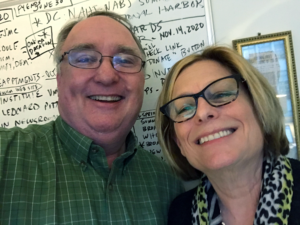Once upon a time, some bright-eyed and enthusiastic journalism grad students at American University came up with a concept for a podcast and tried it out to see what would happen.

Flash forward six years and you’ve got the 400th episode of It’s All Journalism.
And while everything else in the world has changed, our mission has stayed the same: To talk about all facets of the ever-changing industry, one (or two, or six) storytellers and journalists at a time, week by week.
Our first guest, long long ago in August 2012, was Amy Eisman, director of the journalism program in the School of Communication at American University.
“Things have changed,” she says now of journalism in the past few years. “I don’t like to put everything under the concern umbrella. It brings a lot of blame into the tent. Of course I’m concerned that corporate America hasn’t been able to support a lot of what’s happening to local media and leaving news deserts around the country. We have an evolving technology, we haven’t lassoed it, we haven’t figured out entirely how to pay for it. That’s not a blame game; that’s what do we have to keep trying to get the right information to the citizenry so they can make good decisions about democracy. That goal remains the same.”
New tech tools have come and gone, each one promising, or appearing, to be the next big thing and the next great way to share information quickly. But the problem now, even more than in 2012, is being able to discern truth from falsehoods and to see the difference between reporting and an opinion piece.
“Right now, every single day, journalists are being questioned about why they’re saying what they’re saying,” she says. “They have to be better than ever before. I teach journalism to graduate and undergraduate students. We didn’t have to worry about our digital footprint a whole lot. These students have to think about what have I said, what have I said publicly and could it get in the way.”
The ubiquity of social media has “totally changed” the world of journalism, she notes.
Social media and the proliferation of websites that are backed by “bad actors” has changed the world of journalism in ways that were not unimaginable eight years ago, but to a level that might have been inconceivable.
Disinformation spreads in “milliseconds and it’s impossible to catch and bring it back,” Eisman says. “That’s the number one thing facing us in terms of digital media. It’s also the trolling of people who are trying to put information out there in an accurate format. Look at what’s happening to women on social media. It’s outrageous. News organizations are taking away the ability to comment on the bottom of articles because they don’t want their reporters to be accessible to readers in the comments. The good things about social media quickly became bad things. We’re in the middle of an evolution here and it’s not an easy one.”
